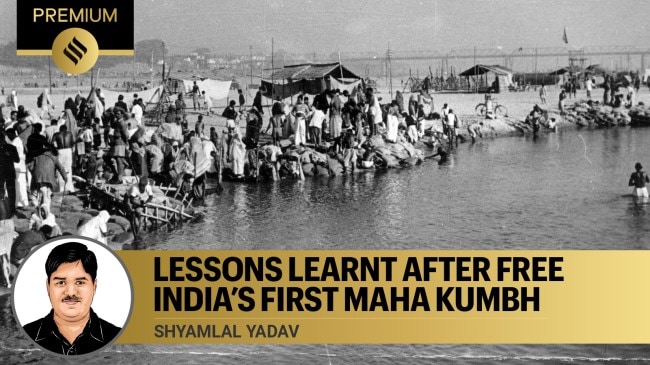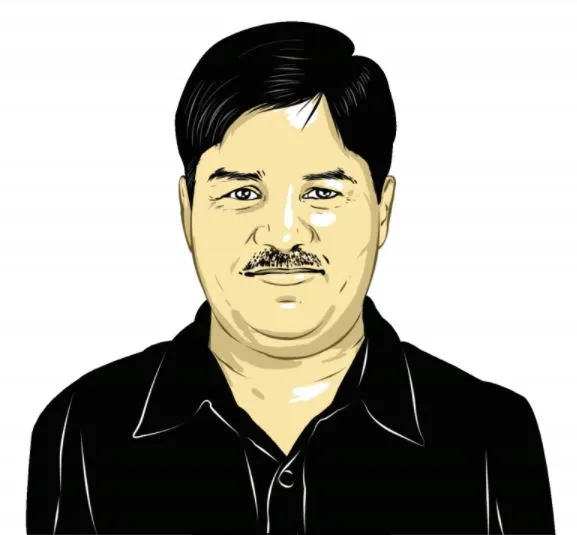Opinion Lessons learnt after free India’s first Maha Kumbh
Twelve years earlier, in 1942, a Maha Kumbh was held in Allahabad under the shadow of World War II. Organised by the British, the number of pilgrims at the 1942 mela were restricted due to “security concerns”.
 Devotees taking a holy dip during Kumbh mela in Allahabad. (Express archive photo)
Devotees taking a holy dip during Kumbh mela in Allahabad. (Express archive photo) Over 70 years ago, Allahabad hosted Independent India’s first mela, from January 14 to March 3, 1954. Instead of being known for its record turnout of nearly 40 lakh devotees — all of whom took a dip at the Triveni Sangam, the confluence of the Ganga, the Yamuna and the mythical Saraswati — the mela is remembered for a stampede on February 3, 1954, that claimed the lives of nearly 800 pilgrims. However, government estimates put the figure at half that number.
Twelve years earlier, in 1942, a Maha Kumbh was held in Allahabad under the shadow of World War II. Organised by the British, the number of pilgrims at the 1942 mela were restricted due to “security concerns”. An Ardh Kumbh (half Kumbh) was held in the city in 1948, but Mahatma Gandhi’s assassination in New Delhi on January 30, 1948, cast a pall over the event. Six years later, in 1954, the Maha Kumbh was held in Allahabad.
 Devotees during the Ardh Kumbh Mela at Allahabad. (Express archive photo)
Devotees during the Ardh Kumbh Mela at Allahabad. (Express archive photo)
A temporary district comes up
Just as it is being done for the 2025 Kumbh, in 1954 too, Kumbh Nagar was named as a temporary district. Allahabad District Magistrate (DM) J N Ugra served as the DM of Kumbh Nagar too, while IPS officer J P Tripathi was designated as the Senior Superintendent of Police (SSP).
Spread over 1,300 acres, the mela was divided into seven sectors managed by area magistrates. Over 2,800 police personnel, including 13 gazetted officers, and 1,000 Armymen, including 27 officers, were deployed to manage law and order, besides other departments, including Public Health and Railways.
SSP Tripathi even issued a booklet for the force that stated, “On the account of Independence, every citizen of our country expects his due from the Police… Our constables posted at the Enquiry Offices must be polite in their behavior to the persons who come to the enquiry offices for making enquiries…”
 A devotee who came crawling from miles away to attend kumbh mela. Express archive photo
A devotee who came crawling from miles away to attend kumbh mela. Express archive photo
Auspicious days and a constellation
The 1954 Maha Kumbh was special on many counts. As per the Hindu calendar for that year, the Kumbh would coincide with many auspicious days: January 14 (Makar Sankranti), February 3 (amavasya or the new moon day), March 3 (Shivratri), seven snan (bath) days, Paush Purnima (full moon day) on the intervening nights of January 18-19 and a constellation that would appear after over a century.
These factors, besides Independence, fuelled devotees’ determination to take a dip at the Sangam during the mela. Recalling his conversations with pilgrims, Vishwanath Prasad Khare, an official deployed at the 1954 Kumbh, had told the inquiry committee set up for the tragedy, “They would say, ‘Mar jayenge, toh tar jayenge. Bach jayenge, toh ghar jayenge. Hamara toh dono mein fayda hai. Aisa bhagya kahan jo aise punya kshetra mein, aisi ghadi me marein (If we die, we will attain salvation. If we don’t, we will go home. We win either way. Lucky are those who die at such a sacred spot and at such an auspicious moment).”
 A view of Ardh Kumbh Mela at Allahabad. Express archive photo
A view of Ardh Kumbh Mela at Allahabad. Express archive photo
Even advisories from the state health department related to a cholera epidemic, effective between January 7 and February 8, 1954, directing persons not inoculated against cholera to not come within 10 miles (around 16 km) of Allahabad, failed to dampen devotee enthusiasm.
Nearly 500 police personnel were deployed at various cholera inoculation centres on the outskirts of Allahabad to check inoculation certificates and to prevent unvaccinated masses from moving towards the city. Since this meant a smaller-than-anticipated turnout at the mela on January 14 that year, reports suggest that many employees deployed for essential services were reassigned by mela authorities.
However, the crowd size would not stay small for long. Protests from all quarters saw the government shut down the cholera inoculation centres abruptly on January 26 and withdraw the advisory — without consulting mela officials. On the intervening new moon nights of February 2-3, the Shravana nakshatra (constellation), last sighted in 1846, made an appearance after 108 years.
 Police personnel checking a sadhu during Kumbh Mela. Express archive photo
Police personnel checking a sadhu during Kumbh Mela. Express archive photo
A sea of devotees and VIP visitors
Besides the sea of devotees, the mela included caparisoned elephants, horses and camels, sadhus brandishing weapons, and bands playing big drums and trumpets. The teeming masses were eager to see these sadhus, touch their feet and take their blessings. While the British government was much firmer with the sadhus during the previous melas, reports suggest the administration found it difficult to enforce similar restrictions in 1954.
On February 3, 1954, the day of the stampede, President Rajendra Prasad, Prime Minister Jawaharlal Nehru, Uttar Pradesh Governor K M Munshi, Chief Minister Govind Ballabh Pant, Punjab Governor C P N Singh, West Bengal Chief Minister Bidhan Chandra Roy and Madhya Bharat (now Madhya Pradesh) Chief Minister Ravi Shankar Shukla were in Allahabad. Save for the Punjab Governor, who visited the site that afternoon, and West Bengal CM, most VIPs went to the Sangam in the morning.
 Crowd gathered at the confluence for bathing. Express archive photo
Crowd gathered at the confluence for bathing. Express archive photo
Around 9 am, a stampede would end up killing hundreds. UP Advocate General Kanhaiya Lal Mishra too got caught up in the stampede. Despite rumours of his death, he managed to get to safety. News of the tragedy was broadcast by All India Radio (AIR) four hours after the incident.
While unofficial accounts state that nearly 800 people, mostly women, the elderly and children, died, official estimates put the number of fatalities between 350 and 400.
Sessions in Parliament and the UP Assembly in the second week of February witnessed several adjournments motions over the stampede. Speaking on the tragedy’s “enormous multitude”, PM Nehru is quoted as telling the Lok Sabha on February 15, “It came as a deep sorrow that, during this tremendous event when so many people had gathered together, there should have been this tragedy in which many suffered death.”
The Centre and the state invited the Opposition’s wrath over the alleged mismanagement of the mela and the visits of VIPs on a major snan day.
In the UP Assembly, among the most vocal Opposition members was socialist Raj Narain. In a stinging attack in the Lok Sabha on February 17 , J B Kripalani of Praja Socialist Party is quoted as saying, “… These sadhu associations passed resolutions supporting the Congress governments, and strengthening the hands of authority, while all the time what was needed was not the strengthening of the hands of authority, but their heads of, and also infusing in them some kind of feeling for the poor…”
 Sadhus during the Kumbh Mela. Express archive photo
Sadhus during the Kumbh Mela. Express archive photo
Committee report and criticism
The report of the enquiry committee set up to look into the stampede suggests that preparations for the event of this scale moved at a rather sluggish pace as of the first week of September 1953. The report of the committee, headed by Justice Kamalkant Verma, notes, “This is late even for an ordinary Kumbh Mela, to say nothing of a Kumbh of the type of the 1954 Kumbh.” However, preparations were made rapidly after that.
The UP government would later invite criticism over its enquiry committee’s terms of reference not including an estimated death toll. The first Kumbh of independent India, which should have gone down in history for its success and magnitude, was overshadowed by a tragedy. However, lessons learnt from the stampede were implemented by subsequent UP authorities during future melas.




